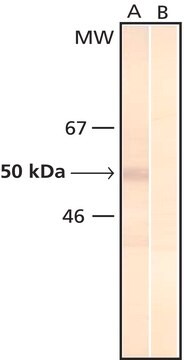ABN1710
Anti-CEP290
from rabbit
Sinónimos:
Cep290, Bardet-Biedl syndrome 14 protein homolog, Nephrocystin-6
About This Item
Productos recomendados
origen biológico
rabbit
Nivel de calidad
forma del anticuerpo
affinity isolated antibody
tipo de anticuerpo
primary antibodies
clon
polyclonal
reactividad de especies
rat, human, mouse
técnicas
immunocytochemistry: suitable
immunofluorescence: suitable
immunohistochemistry: suitable
immunoprecipitation (IP): suitable
western blot: suitable
Nº de acceso NCBI
Nº de acceso UniProt
Condiciones de envío
ambient
modificación del objetivo postraduccional
unmodified
Información sobre el gen
mouse ... Cep290(216274)
Descripción general
Especificidad
Inmunógeno
Aplicación
Immunoprecipitation Analysis: A representative lot detected CEP290 in WT and rd16 retinal extract(Chang, B., et. al. (2006). Hum Mol Genet. 15(11):1847-57).
Immunohistochemistry Analysis: A representative lot detected CEP290 in WT mouse retina (Chang, B., et. al. (2006). Hum Mol Genet. 15(11):1847-57).
Western Blotting Analysis: 1:1,000-1:2,000 dilution from a representative lot detected CEP290 in mouse retina (Courtesy of Dr. Tiansen at NIH).
Immunofluorescence Analysis: A representative lot detected CEP290 in ciliated sensory cells (Rachel, R.A., et. al. (2012). J Clin Invest. 122(4):1233-45) and WT mouse retina (Chang, B., et. al. (2006). Hum Mol Genet. 15(11):1847-57).
Immunofluorescence Analysis: 1:500-1:2,000 dilution from a representative lot detected CEP290 in frozen mouse retina (Courtesy of Dr. Tiansen at NIH).
Immunocytochemistry Analysis: A representative lot detected CEP290 in IMCD-3 cells (Chang, B., et. al. (2006). Hum Mol Genet. 15(11):1847-57).
Calidad
Western Blotting Analysis: 1:500 dilution of this antibody detected CEP290 in 10 µg of HEK293 cell lysate.
Descripción de destino
Forma física
Otras notas
¿No encuentra el producto adecuado?
Pruebe nuestro Herramienta de selección de productos.
Código de clase de almacenamiento
10 - Combustible liquids
Clase de riesgo para el agua (WGK)
WGK 2
Certificados de análisis (COA)
Busque Certificados de análisis (COA) introduciendo el número de lote del producto. Los números de lote se encuentran en la etiqueta del producto después de las palabras «Lot» o «Batch»
¿Ya tiene este producto?
Encuentre la documentación para los productos que ha comprado recientemente en la Biblioteca de documentos.
Nuestro equipo de científicos tiene experiencia en todas las áreas de investigación: Ciencias de la vida, Ciencia de los materiales, Síntesis química, Cromatografía, Analítica y muchas otras.
Póngase en contacto con el Servicio técnico




